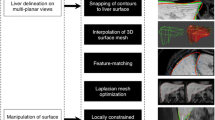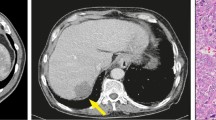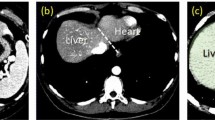Abstract
Purpose
We present a new algorithm for nearly automatic liver segmentation and volume estimation from abdominal Computed Tomography Angiography (CTA) images and its validation.
Materials and methods
Our hybrid algorithm uses a multiresolution iterative scheme. It starts from a single user-defined pixel seed inside the liver, and repeatedly applies smoothed Bayesian classification to identify the liver and other organs, followed by adaptive morphological operations and active contours refinement. We evaluate the algorithm with two retrospective studies on 56 validated CTA images. The first study compares it to ground-truth manual segmentation and semi-automatic and automatic commercial methods. The second study uses the public data-set SLIVER07 and its comparison methodology.
Results
We achieved for both studies, correlations of 0.98 and 0.99 for liver volume estimation, with mean volume differences of 5.36 and 2.68% with respect to manual ground-truth estimation, and mean volume variability for different initial seeds of 0.54 and 0.004%, respectively. For the second study, our algorithm scored 71.8 and 67.87 for the training and test datasets, which compares very favorably with other semi-automatic methods.
Conclusions
Our algorithm requires minimal interaction by a non-expert user, is accurate, efficient, and robust to initial seed selection. It can be effective for hepatic volume estimation and liver modeling in a clinical setup.
Similar content being viewed by others
References
Okada T, Shimada R, Sato Y, Hori M, Yokota K, Nakamoto M, Chen Y, Nakamura H, Tamura S (2007) Automated segmentation of the liver from 3D CT images using probabilistic Atlas and multi-level statistical shape model. In: Proc of the 10th int conf on medical image computing and computer-assisted intervention (MICCAI’07). Lecture Notes in Computer Science, vol 4791. Springer, Heidelberg, pp 86–93
Heimann T, Wolf I, Meinzer HP (2006) Active shape models for a fully automated 3d segmentation of the liver—an evaluation on clinical data. In: Proc of the 9th int conf on medical image computing and computer-assisted intervention (MICCAI’06). Lecture Notes in Computer Science, vol 4191. Springer, Heidelberg, pp 41–48
Lamecker H, Lange T, Seebass M (2002) A statistical shape model for the liver. In: Proc of the 5th int conf on medical image computing and computer-assisted intervention (MICCAI’02). Lecture Notes in Computer Science, vol 2489. Springer, Heidelberg, pp 421–427
Pohle R, Toennies K (2001) Segmentation of medical images using adaptive region growing. In: Sonka M, Hanson KM (eds) SPIE medical imaging, vol 4322, pp 1337–1346
Nakayama Y, Li Q, Katsuragawa S, Ikeda R, Hiai Y, Awai K, Kusunoki S, Yamashita Y, Okajima H, Inomata Y, Doi K (2006) Automated hepatic volumetry for living related liver transplantation at multisection CT. Radiology 240(3): 743–748
Pan S, Dawant M (2001) Automatic 3D segmentation of the liver from abdominal ct images: a level-set approach. In: Sonka M, Hanson KM (eds) SPIE medical imaging, vol 4322, pp 128–138
Schenk A, Prause GPM, Peitgen HO (2000) Efficient semiautomatic segmentation of 3d objects in medical images. In: Proc of the 3rd int conf on medical image computing and computer-assisted intervention (MICCAI’00). Lecture Notes in Computer Science, vol 1935. Springer, Heidelberg, pp 186–195
Lambrou T, Linney A, Todd-Pokropek A (2007) Wavelet analysis of the liver from CT datasets. In: Proc of the 21st int conf on computer assisted radiology and surgery (CARS’07). Springer, Heidelberg
Sosna J, Berman P, Azraq Y, Libson E (2006) Automated liver segmentation and volume calculation from MDCT using a Bayesian likelihood maximization technique: comparison with manual tracing technique. In: 92nd Scientific assembly and annual meeting of the Radiological Society of North America (RSNA’06)
Gao L, Heath DG, Kuszyk BS, Fishman EK (1996) Automatic liver segmentation technique for three-dimensional visualization of CT data. Radiology 201(2): 359–364
Soler L, Delingette L, Malandain V, Montagnat J, Ayache N, Koehl C, Dourthe O, Malassagne B, Smith M, Mutter D, Marescaux J (2001) Fully automatic anatomical, pathological, and functional segmentation from CT scans for hepatic surgery. Comput Aided Surg 6(3): 131–142
Chen T, Metaxas D (2005) A hybrid framework for 3d medical image segmentation. Med Image Anal 9(6): 547–565
Teo P, Sapiro G, Wandell B (1997) Anisotropic smoothing of posterior probabilities. In: Proc of the 1997 int conf on image processing (ICIP’97)(3), pp 675–678
Perona P, Malik J (1990) Scale-space and edge detection using anisotropic diffusion. IEEE Trans Patt Anal Mach Intell 12(7): 629–639
Caselles V, Kimmel R, Sapiro G (1997) Geodesic active contours. Int J Comp Vis 22(1): 61–97
Ibanez L, Schroeder W, Ng L, Cates J (2005) The ITK software guide, 2nd edn. Kitware, Inc., Clifton Park. http://www.itk.org/ItkSoftwareGuide.pdf
Melonakos J, Krishnan K, Tannenbaum A (2006) An ITK filter for Bayesian segmentation: itkbayesianclassifierimagefilter. Insight J
Ginneken B.V, Heimann T, Styner, M (2007) 3D Segmentation in the clinic: a grand challenge. http://www.sliver07.org
Author information
Authors and Affiliations
Corresponding author
Rights and permissions
About this article
Cite this article
Freiman, M., Eliassaf, O., Taieb, Y. et al. An iterative Bayesian approach for nearly automatic liver segmentation: algorithm and validation. Int J CARS 3, 439–446 (2008). https://doi.org/10.1007/s11548-008-0254-1
Received:
Accepted:
Published:
Issue Date:
DOI: https://doi.org/10.1007/s11548-008-0254-1




